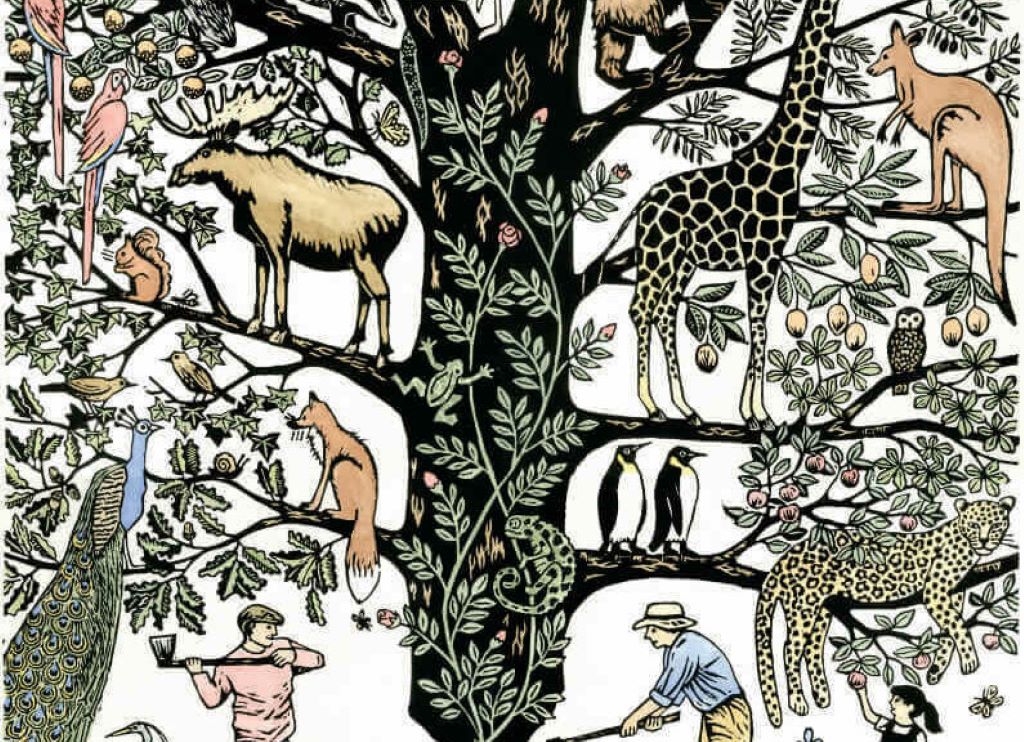I interviewed Stroud-based printmaker and artist Nat Morley about her unique processes, her protest art and her time spent with Barrel Well Aboriginal Community, Australia. Nat was a prize-winning geographer at Oxford University, sings with Tewkesbury Abbey choir, and her artwork is on permanent display at the Cotswold Craftsmen Gallery in Nailsworth.
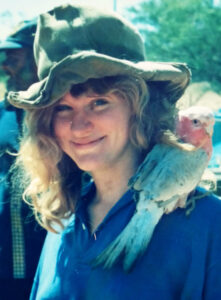
Leslie: What are the main artistic medium/areas you work in? If I saw your work in a gallery, what would be the shared themes that I might notice?
Nat: I have specialised in woodcut prints – actually I carve my blocks out of MDF using lino cutting tools. This enables me to produce larger images than craft lino as MDF is more rigid and is also cheaper. Many of my blocks are a metre long. The subject is wildlife and the style has been described as bold and lively, often with a feeling of movement. I aim for my subjects to be full of character and like depicting exotic creatures such as pangolins, lionfish and birds of paradise. When I started out I felt my work was a celebration of my love for the natural world. At the time I felt our species was too self obsessed. Having said that I do actually enjoy painting portraits so as well as large canvasses of wildlife subjects there are a couple of large portraits in my studio. The process of painting is more free than the woodcut prints. It’s good to have this contrast of disciplines – one being more design led and involving lots of process, the other being more immediate in its expression. I think my style is recognisable across both media though being quite vibrant.
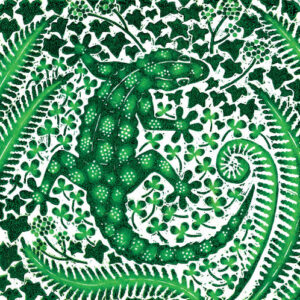
Leslie: How did you learn and develop the skills you use in the areas you work in?
Nat: I learnt my method of printmaking from an inspirational teacher called Simon Packard. I did an access course in art at Stroud college and he taught the printmaking module. I loved the sharp definition of mark-making you get with printmaking. I then continued to attend evening classes Simon ran and worked as his apprentice on a couple of projects. As I couldn’t afford to do an art degree, having used up my funding with my geography degree, I then applied for and was granted Princes Youth Business Trust funding which enabled me to set up a studio in Nailsworth, Gloucestershire. Working alone I developed my own techniques – especially layering colours off the same block using a wiping-away technique that is on my website. Many of my prints use a dark and light shade of the same colour using this technique, which gives them more depth and tonal interest.
Leslie: How does your artist persona relate to the prize-winning geographer from Oxford and the chorister in Tewkesbury Abbey choir?
Nat: Life experience inevitably feeds into an artist’s work. Sometimes this is conscious. For example my ‘6th Mass Extinction‘ print definitely came out of my geography degree. While I carve and print my blocks – the laborious stuff – I like to listen to lectures on YouTube. As a geographer I often listen to lectures relating to climate change and the human impact on the environment which were key topics of my degree. I listened to Peter Wadhams talking about the loss of sea ice in the Arctic and its ramifications.
I listened to Stuart Scott on the methane bubbling out of the permafrost. I listened to Paul Beckwith explaining why the jet stream is breaking up and how this is impacting our weather and will disrupt food production across the bread baskets of the world.
I listened to reports on deforestation and biodiversity loss. This led me to realise the terrible situation we are in at a time when this knowledge still wasn’t out there in the public domain. I had always wanted to produce a woodcut of a tree of life so I decided to extend the allegory by depicting it being chopped down and calling it the ‘6th Mass Extinction’ It was about this time that XR then formed, Greta went on strike and there was a burgeoning of awareness of our predicament.
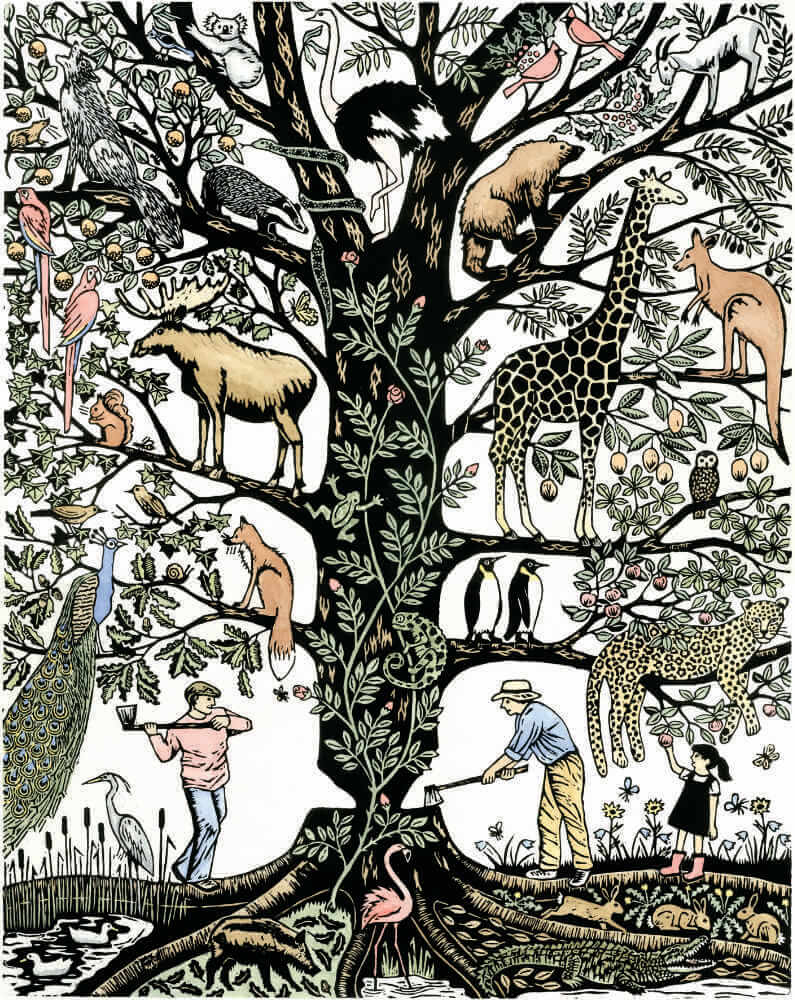
This wasn’t my first protest piece. A few years ago I produced a feminist woodcut that turned the story of the fall of man through Eve eating the apple on its head. I called the picture ‘Enlightenment’ and depicted Eve being presented the apple not by a conniving serpent but by an angel. A sash across the angel’s robes reads ‘here is enlightenment’ in Latin. The snake is there – looking on with envy. The whole picture has a jewel-like quality with lots of red and gold to emulate religious iconography. I always thought that eating the fruit from the tree of wisdom and knowledge surely had to be a passage of enlightenment and feel anger that women have been historically made to feel ashamed and sinful. I think my involvement singing in church choirs led me to come up with this as we still pray to an all-male deity and the church is still very male chauvinist.
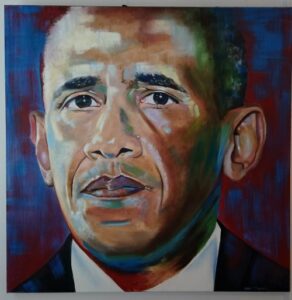
My Obama painting was also a comment at the the time. I painted it after Trump pulled out of the Paris climate agreement. I painted a soulful Obama looking like he is on the verge of crying and called it ‘Feeling Blue’ as a reflection of this situation and a nod to the Democrat colour.
Leslie: As a geographer what did you learn from living at Barrel Well and how has it influenced your art?
Nat: I went to Barrel Well as a young student, mindful of the contrast between traditional Aboriginal culture that views the land as a sacred entity which we, ephemeral beings, have a duty of guardianship over, and our own culture that views the land as something that can be appropriated and used as a resource for making money. I wanted to investigate how this difference played out in the political field re land rights. What I found was a community of outsiders who had suffered appalling human rights abuses. They had a close relationship with nature and the land but it was far removed from traditional Aboriginal society. I formed a very close bond with the community and visited them another two times. We are like family now.
I think my experience at Barrel Well feeds into my role as climate activist very naturally. It is all part of the same problem at the end of the day. Capitalism has alienated us from the land, from each other and the rest of the natural world. As an artist I felt as a species we are too anthropocentric so I chose to depict the other species we share our planet with. I wanted my work to be a celebration, and felt little joy in depicting the world of humans. Strangely people have often commented that some of my pictures have an Aboriginal feel – without realising I have a connection. Maybe it’s because of my use of dots and strong pattern or perhaps it’s the ‘Yamidjee’ now forever part of my psyche! Although it doesn’t directly inform my art I think the ideological standpoint that propelled me to study Aboriginal land rights is still resonant in my artistic ideas today.
Leslie: What’s your experience of working collaboratively as an artist and singer? Have you experienced ego-driven/competitive and exclusive/elitist situations in the arts?
Nat: When I sing in Tewkesbury Abbey I can’t help gazing at the wonderful medieval bosses that decorate the ceiling. Many of them depict angels playing musical instruments so when I was asked to take part in an exhibition linked to Tetbury Music Festival I produced a series of paintings based on these. When one of my daughters was lead singer of an Indie Punk band called ‘Bones Like That’ the band needed images for each of their releases. There were two exceptionally talented artists in the band. The band came to my studio and I gave them a workshop in printmaking which was great fun. They used prints for two of their releases.
I’m happy to say I haven’t experienced any ego driven, competitive, elitist situations in the arts – possibly because not being very competitive or forthright myself I have avoided such situations. I find a lot of galleries terrifying to approach and it’s hard not to take it personally when you get rejected. Being in a guild of Cotswold Craftsmen has been a collaborative and supportive experience. Members are genuinely thrilled if they sell work for another member of the group. We all realise that as art is such a personal thing we are not really competing against each other, but that as a group we have a larger variety of work to offer and are stronger.
Leslie: As an active member of Extinction Rebellion, what kind of art (if any) do you think will survive climate breakdown? Or is all art, in the final analysis, an irrelevant sideshow/self-indulgence as we enter the endgame of advanced life of Earth?
Nat: Since joining Extinction Rebellion I’ve been blown away by the art associated with the movement. It’s been an integral part of the messaging but it also is a great community-builder and consolidator. For example in the last rebellion each regional samba band dressed up as the four elements – earth, air, fire and water and then there were the road-block structures such as the huge pink round table which are monumental art works that send out the message loud and clear and are a focus for rebels. My optimistic self hopes that out of the ashes of climate breakdown the phoenix of a more community-oriented society will emerge in which everyone will be able to engage with creative projects.
We all need to express ourselves and we all like to surround ourselves with things that resonate with us and elevate our everyday experience. I think for as long as there are humans there will be art. It is integral to our need to communicate and express ideas. It is no more or less relevant than our own species which I wish was more of a sideshow in terms of its impact on this planet!!

